Rosé wine conjures up memories of those funky shaped bottles that seemingly everyone used as a candle holder.
Mateus, the Original Rosé wine, is still one of the world’s most successful wines with over 2 million cases produced and distributed around the world. Set aside these memories and fast forward to 2013. Rosé wines, while being some of the earliest wines produced in the world, have enjoyed a resurgence in popularity of late. While still garnering less than 5% of the shelf space of most wine shops, there are some delightful wines that you should seek out to expand your wine tasting palate. Best served chilled, Rosé wines can be the perfect change of pace for the early warm days of spring.
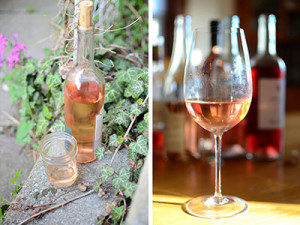 Rosé wines are simply wines that are pink in color, the result of being vinified with only a brief period of contact between the red grape skins and the juice or must. Known as Rosé in France, Rosado in Spain, Rosato in Italy and occasionally “blush” in the U.S., Rosé wines are made from many of the most common grape varieties including Cabernet Sauvignon, Sangiovese, Syrah, Tempranillo, Zinfandel, Merlot, Mourvedre, and Grenache. Rosé wine can be made from a single grape variety but it is more common as a blend. Rosés range in residual sugar from bone dry to quite sweet, rivaling Moscato. Sparkling wines are also made as Rosés.
Rosé wines are simply wines that are pink in color, the result of being vinified with only a brief period of contact between the red grape skins and the juice or must. Known as Rosé in France, Rosado in Spain, Rosato in Italy and occasionally “blush” in the U.S., Rosé wines are made from many of the most common grape varieties including Cabernet Sauvignon, Sangiovese, Syrah, Tempranillo, Zinfandel, Merlot, Mourvedre, and Grenache. Rosé wine can be made from a single grape variety but it is more common as a blend. Rosés range in residual sugar from bone dry to quite sweet, rivaling Moscato. Sparkling wines are also made as Rosés.
Perhaps the easiest way to explore Rosé wines is to travel the globe to the most well-known Rosé wine regions, and examine the styles represented by each.
France
France is most famous for the rich complex red blends of Bordeaux and the Rhone Valley, and the single varietal Pinot Noirs and Chardonnays from Burgundy. Little known outside of the country however, is that to this day Rosé is produced in many of these same regions as well as in the regions of Champagne and Provence. Two thirds of all the wine produced in Provence is Rosé. Bandol, a small Mediterranean seaside village is home to the AOC of the same name, famous for its Mourvedre based Rosé wines. The larger AOC of Cotes de Provence is largely Rose wines with Grenache making up 60% of most blends.
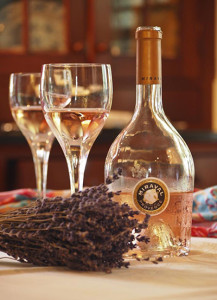
Travelling north from Provence leads to what is perhaps the best of the best of French Rosé wines from the AOC of Tavel, a small wine region in the southern Rhone Valley. Tavel sits across the Rhone River, a mere 10 miles from the famous Châteauneuf-du-Pape. In Tavel however, the only permitted wines under AOC rules are Rosés. Tavel has been a part of viticultural history since the 5th century BC and winemakers from the region provided Rosé wines to Pope Innocent VI in the 14th century. Even U.S. author Ernest Hemingway was said to have knighted a Rosé wine from Tavel as his “favorite wine”. Although there are a large number of grape varieties authorized for Rosé production, Grenache is the most common and is blended with Cinsault, Bourboulenc, Clairette, Mourvedre, Picpoul and Syrah.
Continuing northward to the Loire Valley, Rosé wines are made primarily from the Grolleau grape, a dark skinned, low alcohol high acidity variety found almost exclusively in the Loire Valley. Rosé d’Anjou and Cabernet d’Anjou are the best known AOCs in the region for Rosé wine production; however in 1974 the Rosé de Loire AOC was formed to encompass much of the middle Loire Region. Stylistically, the Roséd’Anjou, is often quite sweet (10 grams per liter of residual sugar is required by AOC rules however le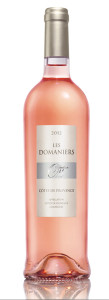 vels in excess of 20 grams per liter are common) and has aromas of strawberry and citrus. On the somewhat drier side, although 10 grams per liter of residual sugar is still required) is Cabernet d’Anjou, an increasingly popular Rosé made from Cabernet Franc and Cabernet Sauvignon. Encompassing a much larger area in the Loire Valley is the Rosé de Loire AOC, which allows Grolleau, Cabernet Franc, Cabernet Sauvignon, Pinot Noir, and Gamay grapes provided that the Cabernet represents a minimum of 30% of the blend. These wines will also be on the drier side with AOC rules permitting a maximum of 3 grams per liter of residual sugar.
vels in excess of 20 grams per liter are common) and has aromas of strawberry and citrus. On the somewhat drier side, although 10 grams per liter of residual sugar is still required) is Cabernet d’Anjou, an increasingly popular Rosé made from Cabernet Franc and Cabernet Sauvignon. Encompassing a much larger area in the Loire Valley is the Rosé de Loire AOC, which allows Grolleau, Cabernet Franc, Cabernet Sauvignon, Pinot Noir, and Gamay grapes provided that the Cabernet represents a minimum of 30% of the blend. These wines will also be on the drier side with AOC rules permitting a maximum of 3 grams per liter of residual sugar.
French Producers to look for: Domaine Mordoree Tavel, Jaboulet Parallele 45 Rosé 2010 (50% Grenache, 40% Cinsault, 10% Syrah, 13.5% ABV, Dry), Ermitage du Pic Saint Loup Rose (30% Syrah, 30% Grenache, 30% Mourvedre, 10% Cinsault, Dry), Domain Richou Rose de Loire (Cabernet Franc and Gamay).
Portugal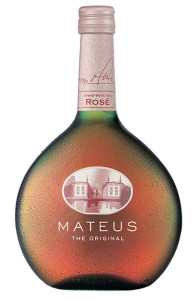
Although not known as a leading Rosé wine region, no discussion of Rosé would be complete without revisiting those memories from the 1970s. In 1942 Fernando van Zeller Guedes, a Portuguese winemaker, decided to risk his family business in the Vinho Verde region by “Americanizing” a lightly sparkling wine by adding sweetness to appeal to the North American market. The bet paid off and Mateus (named after a palace on the Douro River) was born. Today Mateus remains a flagship product of Sogrape Vinhos, which has become the largest wine producer in Portugal.
United States
The United States can lay claim to much of the less than stellar reputation of Rosé wines. Mass produced light and sweet, Rosé wines became known in the 1970’s as blush wines, and attracted a new generation of wine consumers. White Zinfandel, the brainchild of Sutter Home along with a host of wine coolers (back then wine coolers actually contained wine as opposed to malt as they do today), White Merlots and private labeled blush wines commanded nearly a quarter of all wines consumed in the United States by the mid-1990s. In recent years however wine consumers have moved on to focus on the more traditional 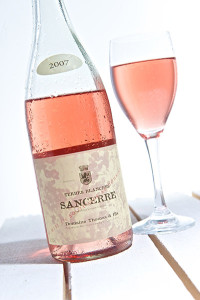 Rosés produced in the Old World style.
Rosés produced in the Old World style.
Make no mistake however; Blush wines are still a major market in the United States. Producers such as Franzia, Sutter Home, Beringer, Almaden, Canyon Oaks, Gallo, Carlo Rossi, and Robert Mondavi crank out millions of gallons in everything from 5 liter boxes to 500ml tetra paks for wine consumers looking for a lighter, sweeter, lower alcohol and unquestionably affordable libation.
U.S. Producers to look for: Truett Hurst Zinfandel Rosé Dry Creek (100% Zinfandel, 15% ABV, Dry), Francis Ford Coppola Sofia Rosé (80%Syrah, 20% Grenache, 12.5% ABV, Dry), Tablas Creek Vineyards Rosé (58% Mourvedre, 30% Grenache, 12% Counoise, 14.5% ABV, Dry).
Rosé Styles
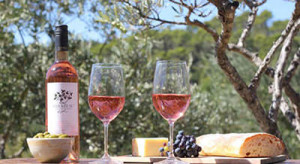 As you can see, Rosé wines are complex because there is no one style. The wine’s color can vary from a salmon pink to a burlesque hot pink depending on the contact time between the juice and the skins. The aroma profile is similar to that of the contributing grape, with the most common being strawberry, cherry and raspberry. The profile will vary considerably between a Merlot based Rosé and a Malbec based Rosé from Cahors.
As you can see, Rosé wines are complex because there is no one style. The wine’s color can vary from a salmon pink to a burlesque hot pink depending on the contact time between the juice and the skins. The aroma profile is similar to that of the contributing grape, with the most common being strawberry, cherry and raspberry. The profile will vary considerably between a Merlot based Rosé and a Malbec based Rosé from Cahors.
One of the best attributes of Rosé wine is its versatility when it comes to food pairings. Since it straddles the line from red to white, it can work with seafood as well as a hearty steak. Best consumed slightly chilled, a good Rose can work well with most any food you carry along on your first picnic of thespring.



 0
0